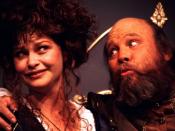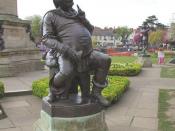Sir John Falstaff's Influence on Prince Hal in I Henry IV
In Shakespearean histories, there is always one individual who influences the major character and considerably advances the plot. In I Henry IV by William Shakespeare, Falstaff is such a character. Sir John Falstaff is perhaps the most complex comic character ever invented. He carries a dignified presence in the mind's eye; and in him, we recognize our internal admiration and jealousy of the rebellious dual personality that we all secretly wish for. The multi-faceted Falstaff, in comic revolt against law and order, in his role as father figure to Prince Hal, and ultimately, in his natural ability to discern and adapt to any situation, emerges as the most complex and paradoxical character in drama.
Frequently, in literature, the sun represents royalty, or in this case the king, who strives to uphold law and order. Rhetorically, the moon, symbolizes instability, not only because it does not remain the same size to one's eyes as time passes, but because it reigns the ebb and flow of the tides.
Therefore, as a knight guided by moonlight, Falstaff is a dissenter against law and order. This conclusion finds support in his witty tautologies and epithets. Falstaff is invariably aware that Hal will one day become king, and when that happens, robbers will be honored in England by "Let[ting] us be indulgence Diana's foresters, gentlemen of the shade, monions of the moon; and let[ting] men say we be men of good government, being governed as the sea is, by our novle and chaste mistress the moon, under whose countenance we steal" (I, ii, 25-30). Falstaff's final dismissal of law and order culminates with a comic plea to the prince, urging him to have nothing to do with "old father antic the law?...


